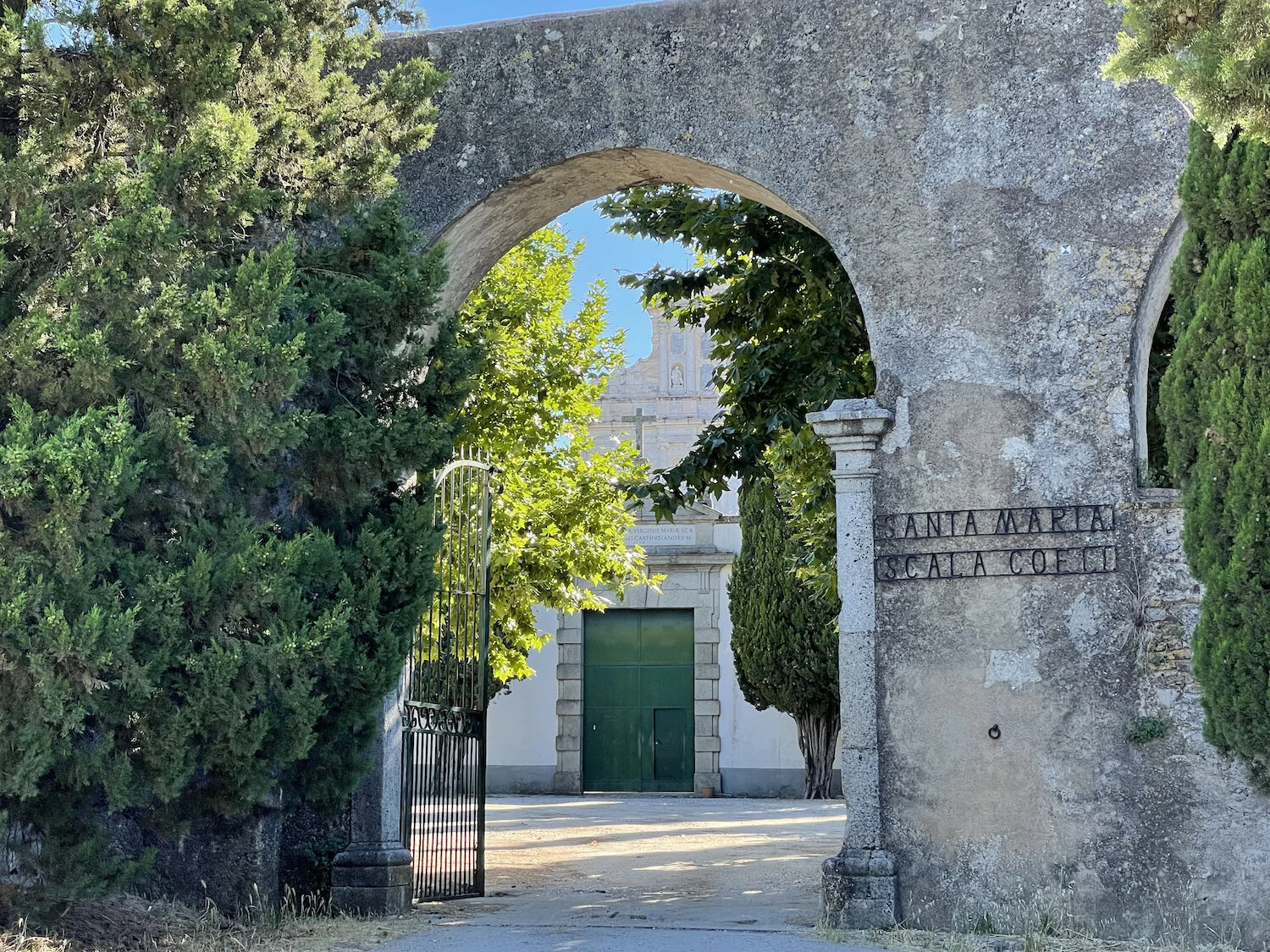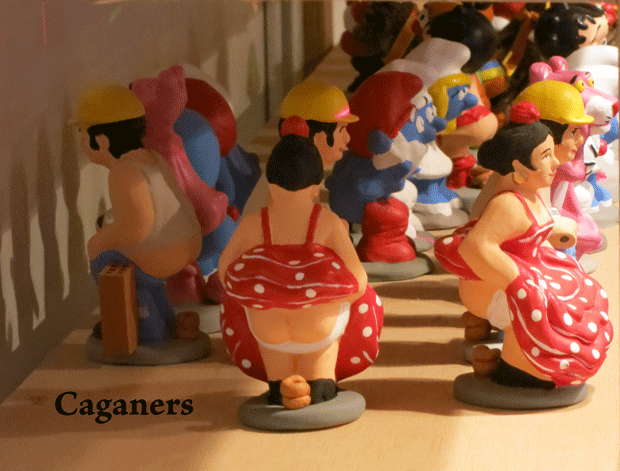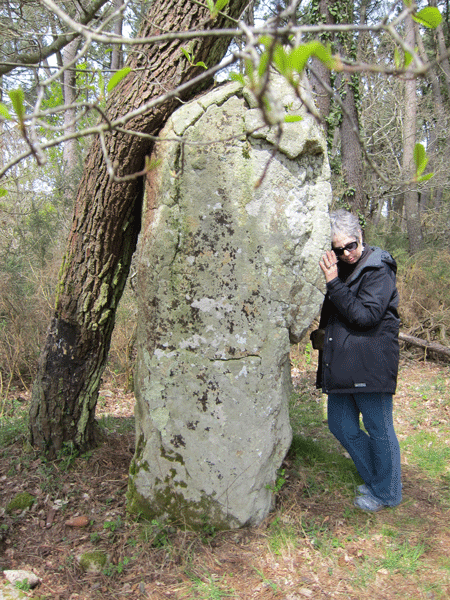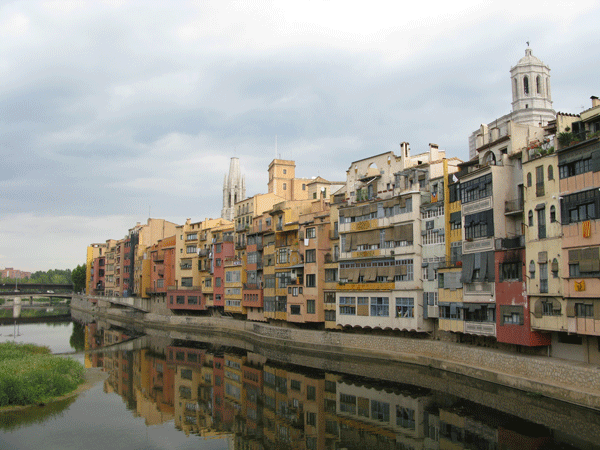A personal tour of the Monastery of Santa Maria Scala Coeli, the Cartuxa de Évora, provides a rare opportunity for Elyn Aviva to discover, and share, a place of great spiritual and cultural significance, unique in Portugal.
All in Religion
Finding Peace in Sand
During a visit to the island of Key West, Florida, writer Kristine Mietzner encounters a Tibetan Buddhist ceremony involving the creation and destruction of a Sand Mandela and finds peace in a troubled relationship.
Misled on St Michael’s Way, Cornwall
by Elyn Aviva
It took nearly 11 years and three attempts for my husband, Gary, and me to complete the 12-mile-long St Michael’s Way across the southern tip of Cornwall. That’s a rather long time for a short walk—probably a record of some sort. And even though we ended up hiking more than 12 miles, we never did manage to walk the middle five.
But we persevered, although we were misled every step of the way.
My husband, Gary, and I recently went to Cornwall to walk meandering paths with a small group. At least, thatwas the story. One morning over breakfast at Rosemerryn House in Lamorna Valley, one of our group revealed she is a professional storyteller. She described learning to take storytelling seriously. “After all,” she mused, “We don’t usually think stories are important. At least, not in the real world.”
I realized that often the word “story” is used as a code word for “false.” As in: “Oh, that’s a likely story! You don’t really expect me to believe you, do you?” Or it’s trivialized to mean something soothing, as in, “Tell me a bedtime story.” Of course, a story is much more than that: it is how we make meaning out of our experiences—as in, “telling the story of my life.” Sometimes I identify so much with my story that instead of me telling “it,” it starts telling “me.”
story and photos by Lori Marquardson
So many reasons for going to Ecuador, but being stuck on a bus full of local Evangelical Christians in a mudslide was not one of them. Sometimes you just have to go with the flow.
I had been backpacking alone through Ecuador and, deciding that a few days exploring the Amazon jungle was in order, made arrangements to meet up with a small group in the dusty oil frontier town of Lago Agrio. From there we would go to the Cuyabeno Nature Reserve for a few days of roughing it with iguanas, howler monkeys, piranhas and blue morpho butterflies.
 River reflections, Cuyabeno Nature Reserve, Ecuador.
River reflections, Cuyabeno Nature Reserve, Ecuador.
A cool drizzle fell as I boarded the overnight bus in Quito. The driver’s personal touches of green fringe and dangling images of saints above the steering wheel couldn’t mask that the bus was more contraption than road-worthy vehicle. My fellow passengers were mostly short and dark, with a number of women wearing the typical Andean dress of black bowler hats, full skirts and rubber sandals while I, the obvious foreigner on board, sported beige zip-off pants and a purple windbreaker. We headed northeast, following the twisting mountainous roads leading out of the city, and despite the jolting motion, I drifted off.
At some point, I came to: the bus was not moving, no engine running, nada. I could see the driver had relaxed into what was definitely a non-driving position: head tilted back, mouth agape, arms crossed over his chest, and legs spread-eagled. Strange, but having been in South America for quite some time, I had experienced unexplained delays before and generally they weren’t show-stoppers, so I tried to fall back asleep. Then came a huge rumble outside, followed immediately by murmuring voices inside.
“What the hell is that?” I said to no one in particular and, being in the front row, I leaned over to the driver, and asked “¿Qué está pasando? “
“Hay un derrumbe.” A landslide. Hmmm, that did not sound good.
My Journey to the Union of Heaven and Earth
by Elyn Aviva
Join me on a journey into the unknown, where what you think you know melts away and is replaced by something bigger.
Falling in Love with Wells Cathedral
by Elyn Aviva
I never thought I’d fall in love again. And certainly not with a building! Yet there I was, heart pounding, eyes damp at the sight of her.
Funny how the first few times I’d seen her, I never felt this “hit” of passionate connection. But that’s often how love strikes us, isn’t it? Not much interest at first—but then, Pow! Like a thunderbolt.
Revelations at a Convent
by Kristine Mietzner
When I walked through the tall wooden doors of the Santa Sabina Center, thirty minutes north of San Francisco, I hoped for rest and revelations about what was next in my life. The former convent is tucked away in San Rafael among oaks and eucalyptus, and it is a place for quiet, contemplation, and meditation. Exactly what I needed.
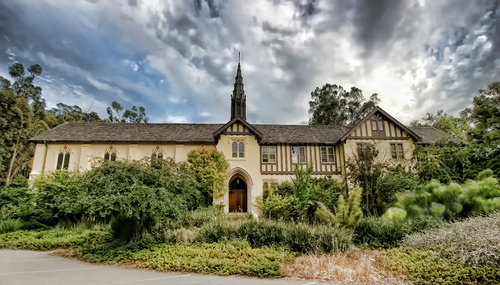
On that rainy May weekend, I sought a break from navigating the litigious end of a long marriage. I was a sailor caught in a storm of emotions, seeking a safe harbor. No talking, just a place to take my tired self to bind my wounds, shed disappointments, and release anger.
Just as I was falling into bed in a room that once housed Dominican novitiates, my cell phone rang. Why was I getting a call at 9:30 p.m. from the father of my children? I jumped to the fear that my son or daughter might be hurt, so I answered the phone. Big mistake.
The kids were okay but he, an attorney, wanted to talk about our unsettled property issues. I didn’t. I referred him to my attorney. Before we hung up, I said, “Don’t call me again this weekend.” Sighing, I turned off the phone.
Then I berated myself. How foolish could I be? I knew better than to take a call from my ex-husband while on a spiritual retreat.
I stopped myself from a bitter downward spiral by recalling that the marriage had had its good years. We were blessed with two incredible children. I found some compassion for myself. It was okay that I answered the phone and besides, I had ended the call quickly.
Opening the window, I inhaled the eucalyptus-scented air, listened to the soft, steady rainfall whispering in the night, and reflected on how far I’d travelled in my post-marriage years.
Right from the beginning of the unraveling of my marriage, I knew that forgiveness would unlock the door to my new life, but finding the key proved challenging. How could I forgive someone I perceived as trying to take advantage of me?
Have a Happy Crappy Christmas Catalonia-Style
by Elyn Aviva
Bon Nadal and Feliç Any Nou! That’s Catalan for Merry Christmas and Happy New Year.
It’s the holiday season in my home town, Girona, Catalonia, and things aren’t quite what you might expect. Yes, there are the familiar ho-ho-ho Santa Claus figures dangling from buildings, and three-foot-high Christmas trees with matching pink and purple ribbon decorations are lined up outside stores on the main shopping streets.
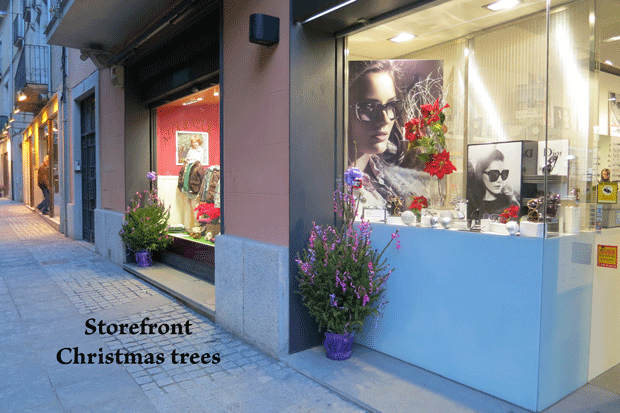
There are brilliant-colored lights strung across the avenues, and a glittering conical abstraction of a Christmas tree pulses on and off in the Plaza de Catalunya. Christmas carols (sometimes in English) echo through the halls, the beauty salons, and the restaurants, and carolers emote as they stroll down the pedestrian Rambla, songbooks in hand. Flame-red poinsettias are for sale in the market, and school-club fundraisers hawk chocolate bars and handmade knickknacks. And there’s the cheery Firanadal (Christmas Fair) offering artisanal goods, felt slippers, jewelry, plastic toys, and boxwood spoons.
Yes, all of this is vaguely familiar, even if gigantes (giant dancing king and queen figures), a marathon Nativity play (Els Pastorets), xuixus (pronounced “choochoos”: sugar dusted, cream-filled pastry rolls), and turrón (a kind of nougat) aren’t usual Christmas fare.
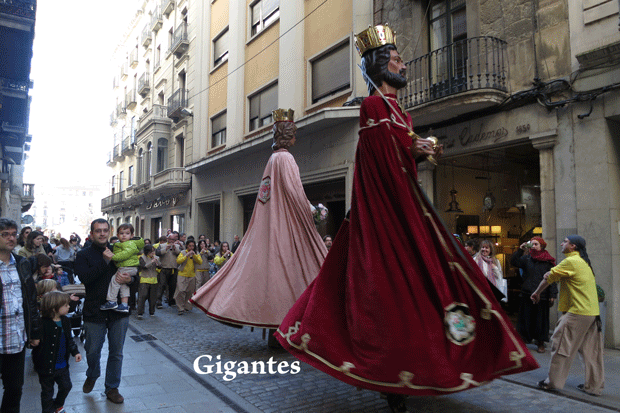
But you really know you’re in a foreign land when you seen the rows of squatting miniature figures—including SpongeBob SquarePants, flamenco dancers, Obama, Barça soccer star Messi, Queen Elizabeth II, and Death—their pants pulled down, a brown plop of poop deposited behind them, for sale for inclusion in Nativity scenes. Correction: the plop of poop behind Death is white, not brown.
What If Something Happens?
Squeezed between napping young people in a tour van, I doubted that this Virgin del Carmen dance festival weekend was a good idea. I’d finished my bottle of water. The driver was swerving down rough roads toward a Peruvian village 3,200 meters high. Weak and dehydrated from several medications, I felt nausea with each lurching switchback.
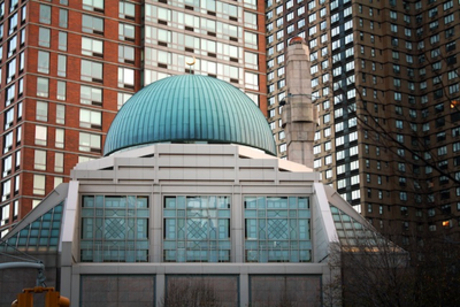 I had been struggling with my prayer life, figuring out where and how I could have some peace and quiet in the Big Apple. I tried to petition and call on God, but the words wouldn't come. I wondered, “If a city never sleeps, how does it ever dream? How do its people ever come to a solemn state of rest?” My father, a Christian of no particular denomination, suggested I visit a mosque and learn from the Muslims.
I had been struggling with my prayer life, figuring out where and how I could have some peace and quiet in the Big Apple. I tried to petition and call on God, but the words wouldn't come. I wondered, “If a city never sleeps, how does it ever dream? How do its people ever come to a solemn state of rest?” My father, a Christian of no particular denomination, suggested I visit a mosque and learn from the Muslims.
“Watch them pray,” he said, “Their discipline and devotion is admirable. Watching them pray at the exact same time every day was one of my favorite things about living in the Middle East.”
I say I am a well-traveled Filipina, but that only means I have made countless layovers on flights to and from New York. The most traveling that I have ever done is through reading books, therefore I have great expectations of places I have yet to see. I hear “India” and I think saris in vibrant colors, citrus rinds covering a plate of curry, or yogis in lotus position. I hear “Rio de Janeiro” and I think futbol, futbol, futbol!
When I hear the word “mosque,” a flipbook of ideas, images, sounds, and even smells pop into my head. I let my mind cruise through this Rolodex as I sit in the Pelham-bound 6 train. Here I am, a young Protestant raised in a Catholic country, managing all the thoughts sweeping through my head as I near the New York Mosque. I straighten my spine and fix my hair as I get off the train, forcing myself to be, or seem to be, more reverent than I usually am.
Nine Mornings of Christmas
by B.J. Stolbov
I’m startled awake by every dog in the neighborhood going off, howling and barking. I’ve never heard such an ungodly uproar. Nothing like this has happened here before. It’s pitch black outside. There are no streetlights in this neighborhood; there are no streets, only dirt trails out there. I roll over and look at my clock. It’s 3:30AM. I have no idea what’s going on.

There’s a light on in the kitchen and my host Mother is up. She is boiling water, making herself a cup of tea.
“What’s going on?” I ask.
“Mass,” she answers.
“Mass?”
“Four o’clock mass.” She sits down. “The Catholics are going to church.” She sips her tea.
“At four o’clock?”
It’s nine days before Christmas. The Philippines is the only Christian country in Asia. Beginning this morning, December 16, the Christians will get up and go to early morning mass every day until Christmas. The Catholics have to wake up this early because their churches will be full and the mass will start exactly at 4AM.
My host Mother, sitting in her bathrobe, heating a larger pot of water for her bucket shower, is Protestant, a Methodist. For the next nine days, she will attempt to attend morning services at the much more reasonable hour of 6AM. And she invites me.
I’ve been living in the Philippines for a year now. I’m a 61-year-old male and, among other various professions, I’m a writer. Rather than retire, I’m way too young to retire and this writer doesn’t want to retire, I decided to join the Peace Corps. Now, I’m living a fascinating life with a Filipino family and teaching high school English in one of the most remote and beautiful provinces in the Philippines.
words + photos by Rachel Dickinson
This summer while on a pilgrimage of sorts to Germany to see several Women’s World Cup soccer matches, I stumbled across something that kept me dipping into every cathedral in every town I visited. I discovered the appeal of the relic.
The Alignments in Carnac, Brittany, France
words + photos by Elyn Aviva
We drove around a corner and encountered an astounding sight: row after row of standing stones, stretching to the horizon. “Pull over!” I demanded. Barely waiting for Gary, my husband, to stop the car, I opened the door, jumped out, and ran over to the green metal fence that separated the stones from me. I shook my head in disbelief, in awe. So many stones, lined up and going—where? Why? They fit no category I knew: they were an enormous puzzle of countless granite megaliths pointing to the sky, rooted in the earth. Hundreds, thousands of stones lined up in slightly wavering rows that went on for kilometers, as if the stones were frozen in the act of marching—somewhere. What was the point? What did they mean? What were they for? The stones made no response. 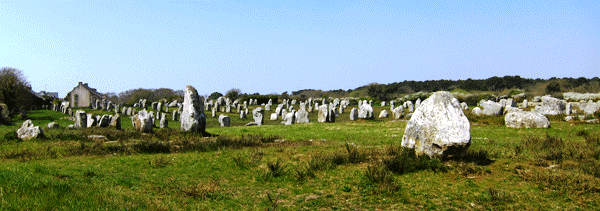
Nowhere in the world has as many megalithic sites as Brittany, and Carnac is in the center of them. The amazing profusion of ancient remains includes isolated standing stones, rows of alignments, earth-covered tumuli, quadrilateral and oval enclosures, and table-like dolmens, each with its own energy and story.
The dolmens with their elaborately engraved interior walls are intriguing, but the 6000-year-old alignments fascinate me. Many of the original stones have been hauled off for re-use in nearby farmhouses and fences, but nearly 3000 menhirs (Breton for standing stones) remain. They are lined up in three sets of slightly undulating rows facing approximately northeast/southwest and extending for kilometers. Starting in the northeast are the Kerlescan alignments, followed by the Kermario alignments, and ending in the southwest with the Le Ménec alignments. The different sets contain from eleven to thirteen rows, and include from approximately 600 to nearly 1200 standing stones. Each set ends in the southwest with an ovoid or quadrilateral stone enclosure (or what remains of one). The cumulative effect of so many stones, so many alignments, extending for such a distance, is awesome.
Healing at Saint Onenn’s Holy Well, Brittany
words + photos by Elyn Aviva
It was a place you couldn’t find unless you’d already been there—or unless you found someone to take you there, someone with permission to cross from here to there….
While my husband, Gary, and I spent the day in Paimpont, our traveling companions visited a holy well in the nearby village of Tréhorenteuc. By chance, they had met someone in a bookstore who told them about it and led them to it. They had dangled their feet in the water and meditated, one by one. It was a lovely place.
The Black Virgin of Rocamadour
words + photos by Elyn Aviva
She called to me just as I was falling asleep, exhausted from too much travel. We had had a long, twisting drive to reach her sanctuary, perched on the side of a sheer bluff in the Lot region in southwestern France. My husband, Gary, and I had gone to bed early, around 9:30 p.m., too tired to enjoy a night stroll through the tiny medieval village of Rocamadour, which sheltered her chapel.
I was almost asleep when I heard her loud and clear, as if she were standing next to me. “Get up!” she commanded. “Come visit me in my sanctuary! That’s what you’re here for!”
I groaned. I was tired. Besides, I’d already visited the Black Virgin of Rocamadour in her sanctuary just a few hours earlier, right after we had arrived, because we’d been told her chapel would close at 7:30 pm.
I turned to Gary, lying next to me in bed. “She’s calling me.”
“What?” He mumbled.
“The Lady is calling me to visit her. You want to come?”
He muttered something. Then, “You go ahead.”
Suddenly energized, I sprang out of bed and got dressed. After all, when the Goddess calls you, you have to go. I knocked at the room next door where our friend Anne was staying. I knocked again, louder. After a few minutes she opened the door, looking sleepy.
“The Black Virgin is calling me to go to her. Want to come?”
She nodded. “Give me a minute.”
Soon we were on a night-time pilgrimage to the Goddess, walking through the silent, deserted streets, climbing the 223 steps of the Grand Staircase that lead up to her cliff-side sanctuary. We followed the Rue de la Mercerie to a small square, the Parvis de St-Amadour, center of the holy precinct. Then we walked up to the upper landing and stood in front of the chapel doors. They were locked.
I shook my head, disappointed. “I know we were told the sanctuary would be closed, but I’m sure the Black Virgin told me to come and see her.” Maybe it had just been a daydream, I thought, or a moment of confusion as I drifted off to sleep….
by Judith Fein
[more from our SPOTLIGHT ON PORTUGAL series this week... ]
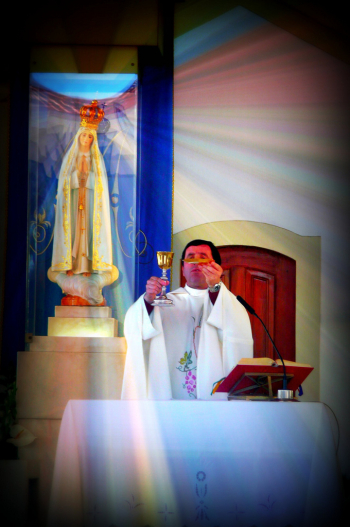 photo by erin-thérèse via flickr (common license)Do you believe in miracles? How else can you account for what happened in a field in central Portugal on May 13, 1917, when three shepherd children saw a vision of the Virgin Mary? Purportedly, she told the awe-struck kids that she would appear at the same spot on the l3th of the five following consecutive months. According to believers, up to 70,000 witnesses beheld a miraculous apparition on the 13th day of the last month. Go to Fatima yourself to see if you are uplifted, transported, or merely interested. It’s about one and a half hours from Lisbon by train. The three children are buried in the sanctuary, and in one outdoor area the faithful light long beeswax candles that intertwine as they melt and carry prayers to heaven. Be sure to visit the museum, where Marians from around the world—including Pope John Paul—have left objects that are precious and significant to them. The latter even donated the bullet that was used by the man who tried to assassinate him. He believed that the Virgin of Fatima saved him.
photo by erin-thérèse via flickr (common license)Do you believe in miracles? How else can you account for what happened in a field in central Portugal on May 13, 1917, when three shepherd children saw a vision of the Virgin Mary? Purportedly, she told the awe-struck kids that she would appear at the same spot on the l3th of the five following consecutive months. According to believers, up to 70,000 witnesses beheld a miraculous apparition on the 13th day of the last month. Go to Fatima yourself to see if you are uplifted, transported, or merely interested. It’s about one and a half hours from Lisbon by train. The three children are buried in the sanctuary, and in one outdoor area the faithful light long beeswax candles that intertwine as they melt and carry prayers to heaven. Be sure to visit the museum, where Marians from around the world—including Pope John Paul—have left objects that are precious and significant to them. The latter even donated the bullet that was used by the man who tried to assassinate him. He believed that the Virgin of Fatima saved him.
Perhaps, while you’re in Portugal, you’ll want to find out about the secret Jews in the mountains of central Portugal who were forcibly converted to Catholicism during the Inquisition. After half a millennium of hiding their identity, they finally came out. In Belmonte, where a museum tells the story and shows the artifacts, you’ll be swept into a world where people clung to their religion in the face of great danger and, in the end, faith triumphed over oppression. There is also a synagogue, and you may be fortunate enough to meet some of the Belmonte Jews. When they decided to publicly claim their heritage and faith—about twenty years ago-- the story captivated people round the world, and now Belmonte is one of the top stops in the region for visitors of all religions.
The Camino de Santiago: An Inner and Outer Journey
by Elyn Aviva
I first heard about the Camino de Santiago in 1981 from my friend Michael, when I was looking for a topic for my Ph.D. in cultural anthropology. Michael idly mentioned there had been an important medieval pilgrimage road in Spain and suggested I look for it—I might find its art and architecture of some interest.
In the summer of 1981 I arrived in Spain, still looking for a topic for anthropological fieldwork. I ended up in Sahagún, a small town in the north-central province of León, where I stayed at the Benedictine nuns’ guesthouse.
I Heard The Call of Girona
by Elyn Aviva
I heard the Call whisper to me as I pressed my hands against its crumbling grey stones. I was standing in the medieval Jewish quarter in Girona, aka “The Call,” a Catalan word based on the Hebrew qahál, which means “a meeting or a gathering.” And gather they did, long ago, the Jewish residents of Girona, Spain, in the winding streets and narrow alleys, in the covered corridors and on the steep-stepped sidewalks. Hurrying to work, to play, to study, hurrying to synagogue to pray. They arrived in 898 and for 500 years they were integrated into the city—except for those dreadful times like 1391 when suddenly they weren’t and they became the targets of violence and repression.
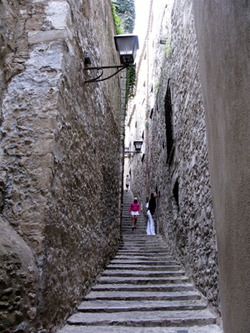 I had seen their traces in the Museum of Jewish History, housed in what had been the Girona synagogue until 1492 when all the Jews were expelled, ending 500 years of coexistence. Suddenly they were gone, all gone, forced from their temple, their homes, their land, and sometimes from their faith.
I had seen their traces in the Museum of Jewish History, housed in what had been the Girona synagogue until 1492 when all the Jews were expelled, ending 500 years of coexistence. Suddenly they were gone, all gone, forced from their temple, their homes, their land, and sometimes from their faith.
I had seen what little they had left behind, displayed in the museum’s evocative exhibits. One gallery held fourteenth-century limestone gravestones, engraved in Hebrew (“Josef, a young child who was a lover of joy, the son of Rabbi Jacob. May he be present in Glory, protected by his Rock and his Redeemer" and “the honored Estelina, wife of the distinguished and upright Bonastruc Josef. May she have her mansion in the Garden of Eden”). Other galleries were filled with rare artifacts, facsimiles, and borrowed objects, with modern reconstructions and pictorial displays. Nothing else remained of the once-thriving community—except its reputation. Not even time’s amnesia could silence that, for Girona had been the center of a famous medieval school of Kabbalists, those mystical philosophers who believed the universe was made manifest in ten emanations.
The most famous Kabbalist of that time was Rabbi Moses ben Nahman (also known as Ramban or Nahmanides), born in Girona in 1194 and died in the Holy Land in 1270. In 1263 King James I of Aragón (a personal friend) summoned him to Barcelona to defend Jewish beliefs against the Dominican Pablo Christiani, a Jewish convert to Christianity. King James awarded Nahmanides a prize and declared that never before had he heard "an unjust cause so nobly defended."
words + photos by Elyn Aviva
Souls in the form of lizards and snakes slither their way to the seashore sanctuary of San Andrés de Teixido in northwestern Spain. At least that’s what local Galician folklore claims about this hard-to-reach pilgrimage shrine, perched on a cliff on the Costa da Morte. “If you don’t go there before you die, you’ll have to go there afterwards”—or so the legends assert. So why not go now, I thought to myself? It would certainly be simpler and more convenient. Besides, I was intrigued by these Celtic-tinged stories of transmigration of souls in what appears to be a deeply Catholic country.
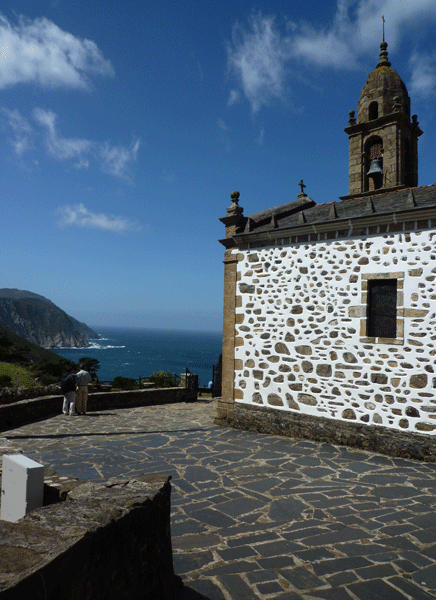 Rather than slither, I went by car, wending my way up and around curvaceous roads shaded by huge eucalyptus trees that swayed in the strong Atlantic breeze. Their medicinal scent filled the air. I pulled over near a TV repeater tower to walk a short stretch of the original pilgrims’ path, careful not to kill any insects I encountered en route—after all, they might be souls on pilgrimage. Or so the legend goes.
Rather than slither, I went by car, wending my way up and around curvaceous roads shaded by huge eucalyptus trees that swayed in the strong Atlantic breeze. Their medicinal scent filled the air. I pulled over near a TV repeater tower to walk a short stretch of the original pilgrims’ path, careful not to kill any insects I encountered en route—after all, they might be souls on pilgrimage. Or so the legend goes.
At last I reached the tiny village of San Andrés and left the car in the large parking lot at the outskirts. I strolled down the narrow lane lined with souvenir stands selling wax ex-votos in the shape of body parts, brightly painted hard-baked bread-dough offerings, and tiny bundles of hierba de enamorar, a local pink flower that is supposed to be a love potion. Something for everyone, I thought. But was there anything here for me?
Around a bend I came to the white-washed sanctuary that guards the relics of the apostle San Andrés (Saint Andrew). The church was surprisingly small, given the size of the folklore that surrounds it. Legend says that San Andrés was distressed because so few pilgrims visited his isolated shrine, so he complained to Christ; Christ felt sorry for him and promised that nobody would enter heaven if they hadn’t gone first to San Andrés de Teixido. It was a great marketing ploy, judging by the popularity of the shrine over the last 400 years.
